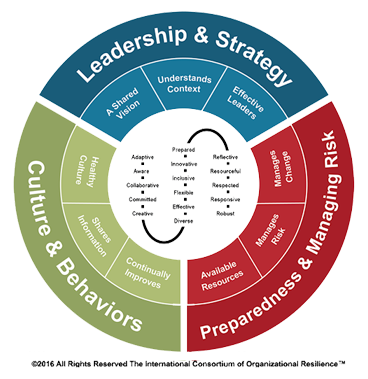
The Role of Senior Leadership in Business Resilience and Best Resilience Practises
In today's fast-paced business environment, organizations face numerous risks that can disrupt their operations and impact their bottom line. From natural disasters and cyber-attacks to supply chain disruptions and pandemics, the need for business continuity and resilience has never been greater. Senior leadership plays a critical role in ensuring that their organizations are prepared for such events and can quickly recover from them. In this article, we will discuss the importance of senior leadership in business continuity and resilience, and best practices for implementing resilience management frameworks, including ISO 22301, ISO 22316, and ISO 22398.
The Role of Senior Leadership in Business Resilience
Senior leadership has a crucial role in ensuring that their organizations are resilient to critical events. They are responsible for setting the tone at the top and establishing a culture of resilience throughout the organization. This means that senior leaders must be committed to resilience management and prioritize it as a strategic imperative. They must also ensure that the organization has the necessary resources and capabilities to prepare for, respond to, and recover from critical events
One of the key responsibilities of senior leadership is to establish a comprehensive business continuity and resilience framework that aligns with the organization's objectives and risk appetite. This framework should include policies, procedures, and processes for risk assessment, business impact analysis, emergency response, crisis management, and recovery. It should also identify critical business functions and assets and prioritize them for protection and recovery. The framework should be reviewed and updated regularly to ensure that it remains relevant and effective.
Senior leaders should also establish clear roles and responsibilities for resilience management throughout the organization. This includes designating a senior executive as the chief resilience officer (CRO) or equivalent, who is responsible for overseeing the development and implementation of the resilience framework. The CRO should report directly to senior leadership and have the necessary authority, resources, and support to carry out their duties effectively. In addition, all employees should be trained in the organization's resilience framework and their roles and responsibilities in the event of a critical event.
Best Practices for Resilience Management
ISO 22301:2019 is the international standard for business continuity management (BCM) and provides a framework for developing and implementing a robust resilience program. ISO 22301 specifies the requirements for a business continuity management system (BCMS) and includes guidance on risk assessment, business impact analysis, emergency response, crisis management, and recovery.  The standard emphasizes the importance of senior leadership in establishing and maintaining a BCMS and requires their active participation and commitment.
The standard emphasizes the importance of senior leadership in establishing and maintaining a BCMS and requires their active participation and commitment.
ISO 22316:2017 provides guidance on organizational resilience and focuses on the ability of an organization to adapt and survive in the face of disruptive events. The standard emphasizes the importance of leadership, culture, and collaboration in building organizational resilience. It also provides guidance on resilience measurement and monitoring, as well as the development of a resilience strategy and implementation plan.
ISO 22398:2013 provides guidance on exercising and testing BCM plans and procedures. The standard emphasizes the importance of regular testing and exercising of BCM plans to ensure their effectiveness and identify any gaps or deficiencies. It also provides guidance on the design, conduct, and evaluation of exercises and tests, as well as the reporting and follow-up of test results.
Implementing ISO 22301,  ISO 22316, and ISO 22398 requires a coordinated effort between senior leadership and the rest of the organization. Here are some best practices for implementing resilience management frameworks:
ISO 22316, and ISO 22398 requires a coordinated effort between senior leadership and the rest of the organization. Here are some best practices for implementing resilience management frameworks:
1.Establish a resilience management team: The team should include senior leaders, the CRO, and representatives from key business functions. The team should be
2.Conduct a risk assessment: A risk assessment is a critical component of any resilience management framework. It involves identifying potential risks and assessing their likelihood and potential impact on the organization. The risk assessment should be conducted regularly and updated as needed.
3.Perform a business impact analysis: A business impact analysis (BIA) is a process of identifying critical business functions and assets and determining their level of importance to the organization. The BIA should also identify the maximum tolerable downtime for each function or asset and the resources needed to restore them in the event of a disruption.
4.Develop and implement a BCMS: Based on the risk assessment and BIA, the organization should develop and implement a BCMS that includes policies, procedures, and processes for emergency response, crisis management, and recovery. The BCMS should be regularly reviewed and updated to ensure that it remains effective.
5.Test and exercise the BCMS:Regular testing and exercising of the BCMS is critical to ensuring its effectiveness and identifying any gaps or deficiencies. Exercises and tests should be conducted at least annually and include all key stakeholders.
6.Monitor and review the BCMS:The organization should monitor and review the BCMS regularly to ensure that it remains relevant and effective. The BCMS should be reviewed at least annually, and any changes or updates should be made as needed.
Conclusion
In today's rapidly changing business environment, resilience management is essential for ensuring that organizations can continue to operate and provide value to their customers in the face of critical events. Senior leadership  plays a critical role in establishing a culture of resilience throughout the organization and ensuring that the organization has the necessary resources and capabilities to prepare for, respond to, and recover from such events.
plays a critical role in establishing a culture of resilience throughout the organization and ensuring that the organization has the necessary resources and capabilities to prepare for, respond to, and recover from such events.
Implementing resilience management frameworks, such as ISO 22301, ISO 22316, and ISO 22398, can help organizations develop and implement robust resilience programs. These frameworks provide guidance on risk assessment, business impact analysis, emergency response, crisis management, and recovery, and emphasize the importance of senior leadership in establishing and maintaining a resilience management program.
By following best practices for implementing resilience management frameworks, organizations can enhance their ability to adapt and survive in the face of disruptive events and continue to provide value to their customers.
Are youprepared to handle critical events? Signup for free
If you intersted to follow our blogs : Subscribe
